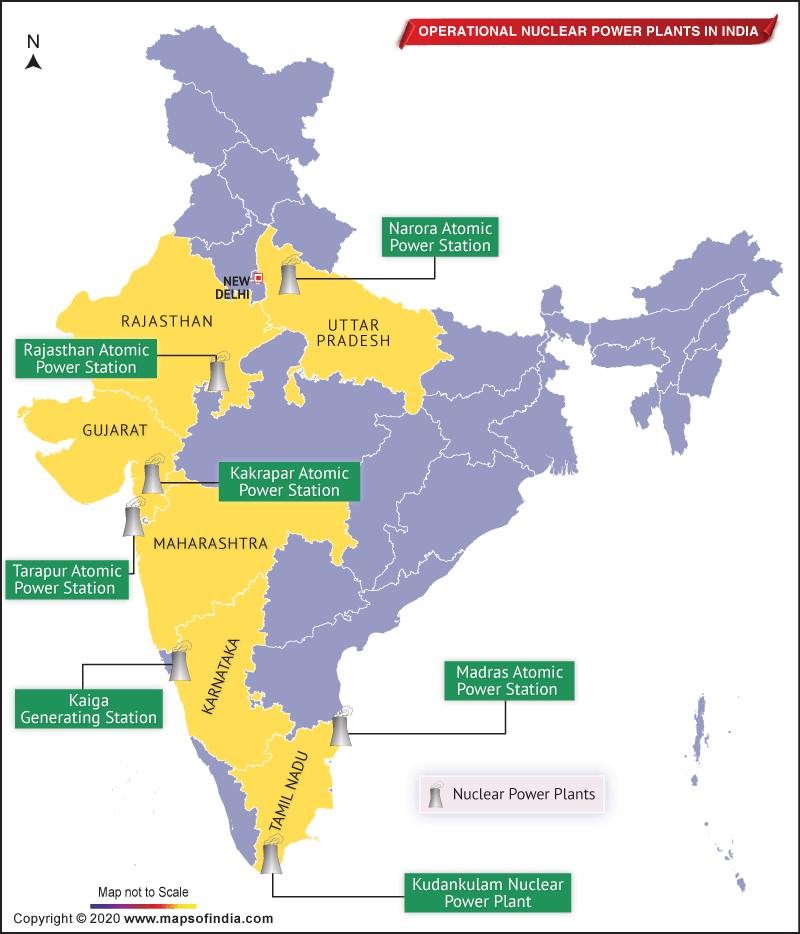Envisaged in 1988, the construction of the Kudankulam Nuclear Power Plant (Koodankulam, Tirunelveli District, Tamilnadu) was implemented on March 31, 2002. Like every other construction project of our country, completion of this nuclear power plant took much longer than planned. The plant was scheduled to generate almost 6 years after the appointed date of 2007. However, it was shut down from October 2011 to May 2012 as a consequence of the protests organized by the People’s Movement Against Nuclear Energy (PMANE), which included the locals from the villages in the vicinity. The nuclear reactions in the plant’s first reactor reached the critical level (i.e., ready to generate power) on July 13, 2013, and the plant was expected to be functional by the end of August 2013. It is to be mentioned here that the Kudankulam Nuclear Power Plant (KNPP), is the 21st nuclear power plant of our country. This nuclear reactor is special in the sense that the plant’s first reactor is the first ‘Pressurized Water Reactor’ (PWR) of our country, pertaining to the ‘Light Water Reactor’ (LWR) class. Referred to as the ‘Voda Voda Energo Reactor’ (VVER), the Russia-built Unit-1 reactor has a completely new technology and a production capacity of 1000 MW. The original budget for this nuclear reactor was INR 13,171 crore, which was later hiked to INR 17,270 crore, with Russia pitching in a credit of INR 6416 crore for the twin units.
The Official kick-off of the Kudankulam Nuclear Power Plant
The first unit of the Kudankulam Nuclear Power Plant became officially functional on October 22, 2013, almost after more than ten years since its construction began. Finally, overcoming the deterring factors like technical hitches and anti-nuclear protest rallies, the first unit began generating and contributing electricity (160 MW), to the southern power grid. While the efforts were ongoing, Prime Minister Manmohan Singh was wrapping up his Russia visit to negotiate for two more Russia-made 1000 MW reactors for the Kudankulam Nuclear Power Plant, which upon full authorization to generate power, will be the largest nuclear reactor of our country. As per the statements of the site director R. S. Sundar, “Last night, 160 MW was connected to the southern grid. This will be increased after checking the generators and conducting other tests”. He added that the Atomic Energy Regulatory Board (AERB) has ratified a production capacity of 500 MW. The Nuclear Power Corporation of India Ltd. (NPCIL), will have to seek the approval of AERB, to hike the production capacities, when the plant attains 50% efficiency.
As of now, the power generation process is in cessation, while the reactor continues to generate steam. As explained by the NPCIL’s executive director, (Corporate Planning and Communications), Mr. N. Nagaich, “After two days, the turbine will be restarted and steam will be passed onto it to produce power.” He added, “This is the normal procedure for any reactor and we are following it for Unit-1. Unit-1 became critical at midnight on July 13 and since then various tests and procedures have been conducted to resolve the problems with safety valves.” It is to be mentioned here that safety-valve problems proved to be quite a challenge to the joint team of Indian and Russian engineers but they successfully overcame the hurdle. As per the statement of the Russian Authorities, nuclear power plants like the KNPP are quite common in Russia and China, with six such units of 1000 MW capacity existing in Zaporizhzhia, Ukraine. With the Unit-1 of the KNPP attaining full-production capacity, it is the state of Tamil Nadu that will reap the maximum benefit, getting 560 MW of the total 1000 MW electricity generated. The second unit of KNPP, with a similar production capacity of 1000 MW, is expected to be functional by June 2014.
Prime Minister Manmohan Singh’s bid to ensure full cooperation from Russia in nuclear power generation
Prime Minister Manmohan Singh was instrumental in wrapping up a deal with Russia, of two more reactors for the KNPP, and had confirmed the finalization of the said deal within a short time, as evident from his statement to the Russian media on October 19, 2013, in Moscow, “Indian and Russian companies had been holding negotiations on finalizing arrangements for Kudankulam Units 3 and 4, and I am confident that these contracts will be finalized shortly”. The PM also asserted that Russia will extend its full cooperation in nuclear energy production and had proffered an alternative location for another reactor setup, in West Bengal, in case the initially purported location at Haripur turned out to be a non-viable option. The government-owned insurance company, General Insurance Corporation (GIC), has been instructed to frame an insurance policy mandating the guidelines for the nuclear components supplied by Russia.
Supreme Court’s green light to the start off of KNPP
Citing the example of the Fukushima nuclear disaster in Japan in 2011, Chennai based IT professional, G. Sundarrajan had submitted a plea to the Apex Court, chasing a stay order on the official commissioning of the KNPP until the appended safeguards, as inferred from the Fukushima Nuclear Disaster, were implemented in the KNPP project. As per the petition submitted before the Bench of Judges chaired by Justice K. S. Radhakrishnan and Justice Dipak Mishra, a suggestion for the implementation of 11 out of the 17 integral key safety guidelines was presented. However, the verdict of the Apex court was one and unanimous. The plea of Sundarrajan was dismissed on the ground that the safety measures undertaken by KNPP were adequate enough, and green light was given to the official commissioning of the KNPP. The Apex court further observed that nuclear power plants are a necessary contributing factor in the economic growth of the country and shall remain so in the present and the future. However, the Apex Court had mandated the submission of a final report, furnishing the minutes of the safety issue of KNPP before the official start off of the said reactor, which was evidently met satisfactorily.
The Government housing development plans for the villagers living in the vicinity of KNPP
In an announcement made on September 14, 2013 the Collector of Tirunelveli, C. Samayamoorthy informed about the Government’s decision of housing development plans for the villagers, residing in the vicinity of the KNPP. Free concrete houses will be allocated under the Rs. 500 crore plan of the government, in an effort for the overall development of the area surrounding the KNPP. A list of village panchayats was drawn up, from which the beneficiaries will be selected under the said scheme. The chosen families will be provided with a concrete house worth Rs. 3 Lakh. Preference will be given to the disabled, women and socially challenged individuals. A total of 10,000 such houses will be allocated under the said plan of the government.
Conclusion
As mentioned before, when fully empowered, KNPP will be the biggest nuclear reactor in India. That said, the fear of the villagers residing in the vicinity to KNPP is not unfounded. Everybody is aware of nuclear hazards in today’s perspective. But apprehension of nuclear hazard comes as collateral when living next door to a functioning nuclear reactor. However, strict adherence to the safety guidelines effectively minimizes the chance of any such disasters. Considering the bigger picture, nuclear reactors are essential as alternative sources of power for the economic growth of the country. The KNPP has proved its worth during the two-hour dry run by generating 160 MW of power and supplying it to the southern grid. The reactor is supposed to generate power in small quantities initially, around 50 MW. Gradually the production will be stepped up to 1000 MW – the full capacity of the Unit-1 of the KNPP. Undoubtedly, KNPP will prove to be an invaluable asset, not only for the state of Tamil Nadu, but for the whole country as well.




